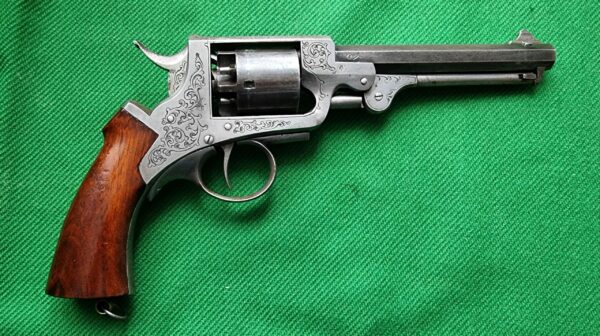Germany
The development of the German percussion revolver began in the early 19th century. At the time, the flintlock pistol was the standard sidearm for most militaries in the world. However, the flintlock was notoriously unreliable and slow to load. In addition, it was prone to misfiring, which could be fatal in combat.
In 1812, a German gunsmith named Johann Nikolaus Dreyse patented a new type of firearm that used a percussion cap to ignite the powder charge. The percussion cap was a small, copper cup filled with a fulminate of mercury. When the hammer struck the cap, it would ignite the fulminate of mercury, which would then ignite the powder charge in the barrel.
Dreyse’s percussion revolver was a major improvement over the flintlock pistol. It was more reliable, faster to load, and less prone to misfiring. In addition, it was more accurate and had a longer range.
The Prussian army was the first to adopt Dreyse’s percussion revolver in 1839. The revolver quickly proved to be a valuable addition to the Prussian arsenal. It was used to great effect in the Franco-Prussian War of 1870-1871, where it helped the Prussians to achieve victory.
The success of the Dreyse percussion revolver led to a wave of innovation in the field of revolver design. Other German gunsmiths began to develop their own percussion revolvers, and soon there were a number of different models to choose from.
One of the most successful German percussion revolvers was the Lefaucheux revolver. The Lefaucheux revolver was designed by Eugene Lefaucheux in 1854. It was a pin-fire revolver, which meant that the percussion cap was integrated into the base of the cartridge. The Lefaucheux revolver was simple to load and operate, and it quickly became one of the most popular percussion revolvers in the world.
Another popular German percussion revolver was the Roth revolver. The Roth revolver was designed by Johann Gottfried Roth in 1857. It was a percussion revolver with a unique rotating cylinder design. The Roth revolver was known for its accuracy and reliability, and it was used by a number of different militaries around the world.
The production of percussion revolvers in Germany continued until the late 19th century. By the early 20th century, percussion revolvers had been largely replaced by cartridge revolvers. However, German percussion revolvers played an important role in the development of firearms technology, and they continue to be prized by collectors today.
Here is a more detailed look at the development of the German percussion revolver:
* 1812: Johann Nikolaus Dreyse patents his percussion cap design.
* 1839: The Prussian army adopts the Dreyse percussion revolver.
* 1854: Eugene Lefaucheux designs the Lefaucheux percussion revolver.
* 1857: Johann Gottfried Roth designs the Roth percussion revolver.
* 1864: The Austro-Prussian War begins. The Dreyse percussion revolver plays a key role in the Prussian victory.
* 1870: The Franco-Prussian War begins. The Dreyse percussion revolver is used extensively by the Prussian army.
* 1871: The Franco-Prussian War ends with a Prussian victory. The Dreyse percussion revolver has proved its worth in battle.
* 1873: The Dreyse percussion revolver is officially phased out of service by the Prussian army. It is replaced by the Mauser Model 1871 revolver.
* 1883: The production of percussion revolvers in Germany ceases.
The German percussion revolver was a significant development in firearms technology. It was more reliable, faster to load, and more accurate than the flintlock pistol. The German percussion revolver played an important role in the development of firearms technology, and it continues to be prized by collectors today.
Showing all 2 resultsSorted by latest

